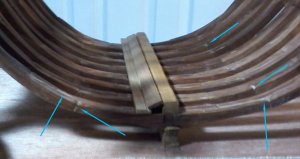Dave, Know what you mean about Drs. and food, I have 2, one says very low sodium, watch out for potasium, the other one say watch out for carbs, and know sugar free sweets, and no caffine which chocalot has, oh well I am still here, and I do lisen and follow what they say, and I have a FOOD POLICE HERE(MY LOVING DAUGHTER)
-

Win a Free Custom Engraved Brass Coin!!!
As a way to introduce our brass coins to the community, we will raffle off a free coin during the month of August. Follow link ABOVE for instructions for entering.
You are using an out of date browser. It may not display this or other websites correctly.
You should upgrade or use an alternative browser.
You should upgrade or use an alternative browser.
Wood it's characteristics and use in model building
- Thread starter Dave Stevens (Lumberyard)
- Start date
- Watchers 40
-
- Tags
- wood wood characteristics
Very interesting and informative thread. Thanks, Dave!
- Joined
- Dec 1, 2016
- Messages
- 6,338
- Points
- 728

The crew brought in another tree so the first thing is to identify the logs
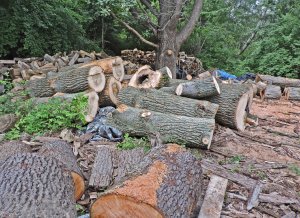
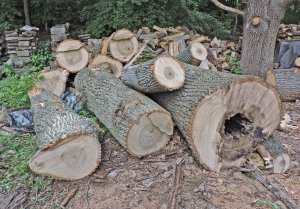
the logs are from 8 to 10 feet long and the butt end of the log to the right is 41 inches this was a big tree so what is it?
family Magnoliaceae which contains 12 genera and 180 species
the logs are Liriodendron common names are Yellow Poplar, Tuliptree, Cucumbertree, southern Magnolia, Whitewood
What is interesting about Magnoliaceae is the fact it is ancient with its ancestors dating back 100 million years. At one time the Poplar grew worldwide but over time and climatic changes over thousands of years have driven the Poplar into isolated regions.
The Poplar is one of the planets largest trees.
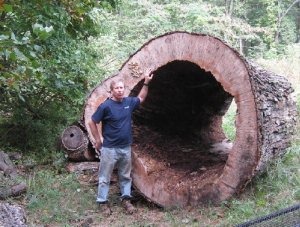
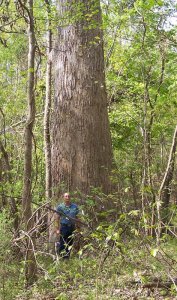
Today you will find the Poplar growing in the northern regions of North America the upper US and Canada. It also grows in the northern temperate regions of Europe and into China.
the wood has been overlooked in the hobby of ship modeling but is now reaching popularity because of its working properties. It has an even very fine texture excellent for carving. This fine texture allows a glass smooth finish even with a light bodied finishes such as Tung oil. The wood also takes paint and stains very well so you can stain the wood any color you choose. No issues with gluing
The trees will grow 60 feet straight up so grain is straight making it perfect for masts and spars, once dry it is very stable and does not warp or move.
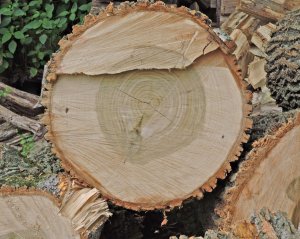
the wood has a greenish heartwood that when exposed to sun light it will loose the greenish color and turn a tan color. The sapwood is wide as you can see in the picture and is a light straw color with a slight cream to pinkish tint.
For model building it is one of the top woods because it is easy to work, it makes perfect deck planking or hull planking.
here is the same log end as above 10 days later facing into the sun the green heartwood changes color.
notice down on the right where that lower log is peeking in, the heartwood will change to maroon color
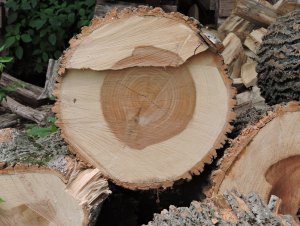


the logs are from 8 to 10 feet long and the butt end of the log to the right is 41 inches this was a big tree so what is it?
family Magnoliaceae which contains 12 genera and 180 species
the logs are Liriodendron common names are Yellow Poplar, Tuliptree, Cucumbertree, southern Magnolia, Whitewood
What is interesting about Magnoliaceae is the fact it is ancient with its ancestors dating back 100 million years. At one time the Poplar grew worldwide but over time and climatic changes over thousands of years have driven the Poplar into isolated regions.
The Poplar is one of the planets largest trees.


Today you will find the Poplar growing in the northern regions of North America the upper US and Canada. It also grows in the northern temperate regions of Europe and into China.
the wood has been overlooked in the hobby of ship modeling but is now reaching popularity because of its working properties. It has an even very fine texture excellent for carving. This fine texture allows a glass smooth finish even with a light bodied finishes such as Tung oil. The wood also takes paint and stains very well so you can stain the wood any color you choose. No issues with gluing
The trees will grow 60 feet straight up so grain is straight making it perfect for masts and spars, once dry it is very stable and does not warp or move.

the wood has a greenish heartwood that when exposed to sun light it will loose the greenish color and turn a tan color. The sapwood is wide as you can see in the picture and is a light straw color with a slight cream to pinkish tint.
For model building it is one of the top woods because it is easy to work, it makes perfect deck planking or hull planking.
here is the same log end as above 10 days later facing into the sun the green heartwood changes color.
notice down on the right where that lower log is peeking in, the heartwood will change to maroon color

Last edited:
Very interesting thread Dave.
So you can say.... wood ain't wood, Sol! (There was a TV's commercial in Australia for Caltex oil. And the catch phrase was 'oils ain't oil, Sol'). This is referring to that their differences from oil companies are enormous, like between spices of wood.happymodeling
Greg
- Joined
- Dec 1, 2016
- Messages
- 6,338
- Points
- 728

the Appalachian hardwood forest is gone because the Dutch starting cutting down the trees way back, then it was a major supplier of the British Navy and the American navy, clearing land for civilization now we have second growth trees all the first growth giants are gone but every once in a while you come across a rare item like this log of Appalachian black cherry on the right to the left is cherry you see in the lumber trade.
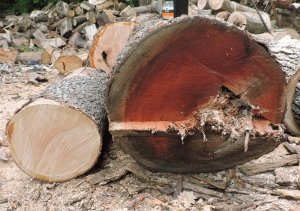

Hi Dave, A quest that I am using Walnut for a lot of my Blandford Build, ther are white spots in the material on the 3 in sheets that I am using, sanding them only makes it worse if yo look at my Blandford build you ca see what I am talking about, I have used Min-Wax Wood Conditioner Ten a coat of Min-Wax Natural stain still the same resultd, WHAT IS HAPPENING AND WHY, is there any method that I can use to fix this up, A lot will be covered up, but the next phase will have a lot it showing, any suggesting as how to aproach this. THANKS Don
- Joined
- Dec 1, 2016
- Messages
- 6,338
- Points
- 728

No THANKS DonDave that is my fault with the glue, it is the DECK CLAMPS one of them, but it is typical, just wondering what kind of finish to use, to see if I can correct this, like I said it is not crtical right now, but could be latter.
- Joined
- Dec 1, 2016
- Messages
- 6,338
- Points
- 728

I see the white area on the deck clamp my guess it is residue of glue that might of been on the table or your fingers when you were handling the wood
what leads me to think it is glue is because the same white areas are on the pearwood frames
only way to get rid of it is to sand it away, depending on the glue some will not take a stain, some soak deep into the wood, walnut loves glue it soaks it up like a sponge.
I found out when I glue things like planking as I am clamping the wood glue oozes out under the clamp. So as I tighten the clamp I am pushing the glue into the grain of the wood. That is hard to sand out because the glue was presses into the wood
![20180804_031126[3351].jpg 20180804_031126[3351].jpg](https://shipsofscale.com/sosforums/data/attachments/34/34407-66220fb6b2fb73fdd97450c8ca1ac2d3.jpg?hash=ZiIPtrL7c_)
what leads me to think it is glue is because the same white areas are on the pearwood frames
only way to get rid of it is to sand it away, depending on the glue some will not take a stain, some soak deep into the wood, walnut loves glue it soaks it up like a sponge.
I found out when I glue things like planking as I am clamping the wood glue oozes out under the clamp. So as I tighten the clamp I am pushing the glue into the grain of the wood. That is hard to sand out because the glue was presses into the wood
![20180804_031126[3351].jpg 20180804_031126[3351].jpg](https://shipsofscale.com/sosforums/data/attachments/34/34407-66220fb6b2fb73fdd97450c8ca1ac2d3.jpg?hash=ZiIPtrL7c_)
Dave and Mike, I just noticed my shot locker has developed the white spots also, they were not there before , THINK I KNOW WHAT THE PROBLEM IS I have been using an ACCELARATOR WHEN I HAVE TO USE CA THAT MITE BE THE PROBLEM. Don
- Joined
- Dec 1, 2016
- Messages
- 6,338
- Points
- 728

Dave and Mike, I just noticed my shot locker has developed the white spots also, they were not there before , THINK I KNOW WHAT THE PROBLEM IS I have been using an ACCELARATOR WHEN I HAVE TO USE CA THAT MITE BE THE PROBLEM. Don
CA glue that stuff is thinner than your average wood glues so it soaks into the wood yup those can be stains from the glue and accelerator
how do you apply the accelerator brush of spray?
you can not stain CA glue so the spots will remain as spots
which is it the glue or the accelerator? may have to stop using the one or the other or both.
seems glue spots is a common "thing"
https://www.woodworkingtalk.com/f8/glue-spots-24933/
Last edited:
Dave I am sure it is the acceerator, as I did not put any CA on the shot locker but sprayed area where I had CA and it turned whit spots, OH WELL LIVE AND LEARN, most o it will be covered up except the shot locker so no more accelerator, and I hate to use CA anyway only where neccessary, I use as little as possiible. Don PS READ YOUR EMAIL
- Joined
- Dec 1, 2016
- Messages
- 6,338
- Points
- 728

getting back to post #83 and those big logs of Poplar, I got out there and started cutting them up
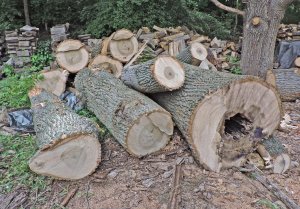
starting with the big log with the hollow center I cut it in 30 inch lengths and then cut 3 x 4 x 30 billets
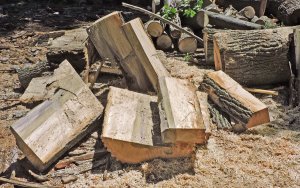
there is a big difference between the white sapwood and the heartwood. In this case it is the sapwood that I am cutting out and the heartwood ends up on the firewood pile.
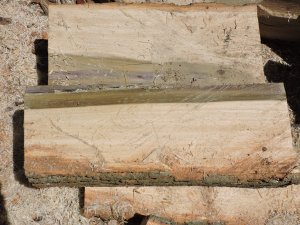
here is a trimmed out billet of poplar
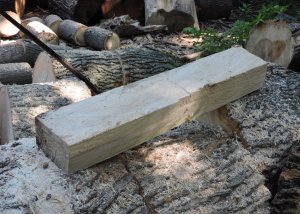
as the billets are trimmed they are stacked to dry. The bark on some edges are still there because when the wood is green the bark is difficult to remove. BUT once the wood begins to dry the bark will separate and pry off with ease. It is not a good idea to leave the bark on because bugs love to get under the bark and eat the wood, the bark also traps moisture so if it does not come off naturally I will go back and pry it off.
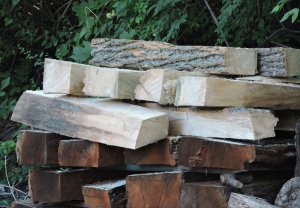
There is a group of model builders who promote certain types of wood for model ship building and if you do not using these woods then your model is not up to par. That is more a load of hype than anything else, yes I agree some types of wood are far better than others but if your not building at a high skill level or at a professional level than it does not matter all that much. Take decking for example this group says for decking you have to use Holly but give no reason why except because we say so. Take that billet of Poplar sitting on the log, it is defect free and a clean piece of wood if it were Holly you can expect to pay as much as $90.00 as Poplar expect to pay $5.00. Why the difference? because Holly is a small tree often with knots and defects. It is difficult to get a piece of Holly that size so it is expensive. As we now know Poplar is one of the largest hardwood trees on the planet so it is common and you can get clear clean pieces so big you could not lift it off the ground.
For you DIY builders you are far better off getting rough billets when the price is low and mill out your own planking.
Just because a wood is 10 times more expensive does not mean your model is 10 times more valuable. The value of a model ship is based on
(1) workmanship (2) subject (3) degree of detail (4) material

starting with the big log with the hollow center I cut it in 30 inch lengths and then cut 3 x 4 x 30 billets

there is a big difference between the white sapwood and the heartwood. In this case it is the sapwood that I am cutting out and the heartwood ends up on the firewood pile.

here is a trimmed out billet of poplar

as the billets are trimmed they are stacked to dry. The bark on some edges are still there because when the wood is green the bark is difficult to remove. BUT once the wood begins to dry the bark will separate and pry off with ease. It is not a good idea to leave the bark on because bugs love to get under the bark and eat the wood, the bark also traps moisture so if it does not come off naturally I will go back and pry it off.

There is a group of model builders who promote certain types of wood for model ship building and if you do not using these woods then your model is not up to par. That is more a load of hype than anything else, yes I agree some types of wood are far better than others but if your not building at a high skill level or at a professional level than it does not matter all that much. Take decking for example this group says for decking you have to use Holly but give no reason why except because we say so. Take that billet of Poplar sitting on the log, it is defect free and a clean piece of wood if it were Holly you can expect to pay as much as $90.00 as Poplar expect to pay $5.00. Why the difference? because Holly is a small tree often with knots and defects. It is difficult to get a piece of Holly that size so it is expensive. As we now know Poplar is one of the largest hardwood trees on the planet so it is common and you can get clear clean pieces so big you could not lift it off the ground.
For you DIY builders you are far better off getting rough billets when the price is low and mill out your own planking.
Just because a wood is 10 times more expensive does not mean your model is 10 times more valuable. The value of a model ship is based on
(1) workmanship (2) subject (3) degree of detail (4) material
- Joined
- Dec 1, 2016
- Messages
- 6,338
- Points
- 728

Remember builders if you read about a wood and it is described one way or another and you buy a piece, then you get something totally different from what you read about. As I showed you with the Steamed pearwood you can get anything from bright pink to purple and every shade in between.
if you just read the above about the clear white color of Poplar and then you see this pieces, same wood same log
I set this piece aside It would make a striking base board to mount a model on. Fill the hollow area with a blue tinted resin and finish the surface and you will have a WOW! that looks nice.
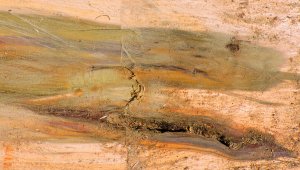
if you just read the above about the clear white color of Poplar and then you see this pieces, same wood same log
I set this piece aside It would make a striking base board to mount a model on. Fill the hollow area with a blue tinted resin and finish the surface and you will have a WOW! that looks nice.

Wow, this is a great thread. I am a retired finish carpenter and cabinet maker. I've used lots of different woods in my life, but never really knew much about them except if they worked easily or not and finished up well. I always loved working on fancy staircases, "built in" cabinet work and raised panel custom doors. Now I do little wooden boats.
Thanks for this thread.
EJ
Thanks for this thread.
EJ
I think Dave decided to send all of us some samples after the teaser. Lol.
- Joined
- Dec 1, 2016
- Messages
- 6,338
- Points
- 728

The tree crew dropped off another load of logs so lets take a look at what is there that log right in front is the top part of a Maple I will cut that into blocks for the local wood turners club. Behind that log is a dead Ash under the Ash is what we call tame cherry or the Cherry that produces the tasty black cherries. There are a few logs of Spruce which will end up as firewood and a couple Maple logs.
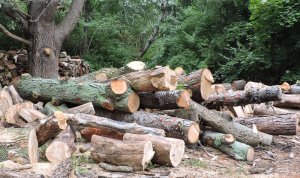
This is the Maple log I will be lumbering, on top of it is the Ash it has some huge knots so once I cut into it I will see if it is worth blocking out or cutting for firewood.
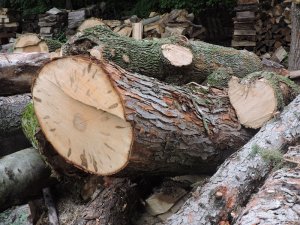
to the left and right are both nice clear big logs of Maple between them are logs of Spruce
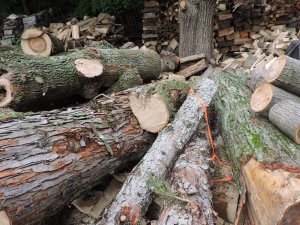
OK then, lets talk about Maple
The Aceraceae family which has 3 genera and 70 species widely distributed over the northern hemisphere.

This is the Maple log I will be lumbering, on top of it is the Ash it has some huge knots so once I cut into it I will see if it is worth blocking out or cutting for firewood.

to the left and right are both nice clear big logs of Maple between them are logs of Spruce

OK then, lets talk about Maple
The Aceraceae family which has 3 genera and 70 species widely distributed over the northern hemisphere.
Last edited:
- Joined
- Dec 1, 2016
- Messages
- 6,338
- Points
- 728

Maple can get confusing because of so many names and lumber which are called Maple and some are not even related or look like maple
What the British call sycamore (Acer pseudoplatanus), the Americans call maple, and what the Americans call sycamore (Platanus occidentalis) the British call lacewood.
Sycomore is the original name of a fig tree cultivated by Egyptians. A debate rages on if the Sycamore is native to England or brought there by the Romans. The "o" in the spelling is not a type mistake it is spelled with an "a" or an "o" depending were in the world you are.
The Kikuyu are the largest community in Kenya, where the African fig sycomore is a sacred tree. All sacrifices to Ngai, the supreme creator, were performed under the tree. Whenever the tree fell, it symbolized a bad omen and rituals had to be performed by elders in the society. Some of those ceremonies carried under the sycamore fig locally called the Mugumo tree are still observed to date
What the Australians call maple (actually Queensland maple, Flidersia braleyana) Although the tree is known as Queensland maple, the family Rutaceae is commonly known as the Rue or Citrus family, and the Queensland maple is more closely related to orange trees than to maple trees.
Then we have African Maple which has nothing to do with the Acer family of maples it is the Obeche (Triplochiton scleroxylon), tree.
Within the true maple family of trees there are a number of names.
Black Maple, Bush Maple, Great Maple, Hard Maple, Red Maple, Rock Maple, Silk Maple, Soft Maple , Sugar Maple, Sycamore Maple, Ash Maple, big leaf Maple, Box Elder maple. Then adding to the list depending on what the wood looks like and its figure we have curly maple, birdseye maple, tiger maple, ambrosia maple. We can also add several maples from Japan, China and Mexico. Even in North America you will find a range of Maples in Canada it is called Moose Wood which is striped, there is eastern silver Maple as white as Holly, on the west coast from Alaska to southern California you will find Oregon or broad leaf maple with deeper colors and figure than eastern maple.
What the British call sycamore (Acer pseudoplatanus), the Americans call maple, and what the Americans call sycamore (Platanus occidentalis) the British call lacewood.
Sycomore is the original name of a fig tree cultivated by Egyptians. A debate rages on if the Sycamore is native to England or brought there by the Romans. The "o" in the spelling is not a type mistake it is spelled with an "a" or an "o" depending were in the world you are.
The Kikuyu are the largest community in Kenya, where the African fig sycomore is a sacred tree. All sacrifices to Ngai, the supreme creator, were performed under the tree. Whenever the tree fell, it symbolized a bad omen and rituals had to be performed by elders in the society. Some of those ceremonies carried under the sycamore fig locally called the Mugumo tree are still observed to date
What the Australians call maple (actually Queensland maple, Flidersia braleyana) Although the tree is known as Queensland maple, the family Rutaceae is commonly known as the Rue or Citrus family, and the Queensland maple is more closely related to orange trees than to maple trees.
Then we have African Maple which has nothing to do with the Acer family of maples it is the Obeche (Triplochiton scleroxylon), tree.
Within the true maple family of trees there are a number of names.
Black Maple, Bush Maple, Great Maple, Hard Maple, Red Maple, Rock Maple, Silk Maple, Soft Maple , Sugar Maple, Sycamore Maple, Ash Maple, big leaf Maple, Box Elder maple. Then adding to the list depending on what the wood looks like and its figure we have curly maple, birdseye maple, tiger maple, ambrosia maple. We can also add several maples from Japan, China and Mexico. Even in North America you will find a range of Maples in Canada it is called Moose Wood which is striped, there is eastern silver Maple as white as Holly, on the west coast from Alaska to southern California you will find Oregon or broad leaf maple with deeper colors and figure than eastern maple.



